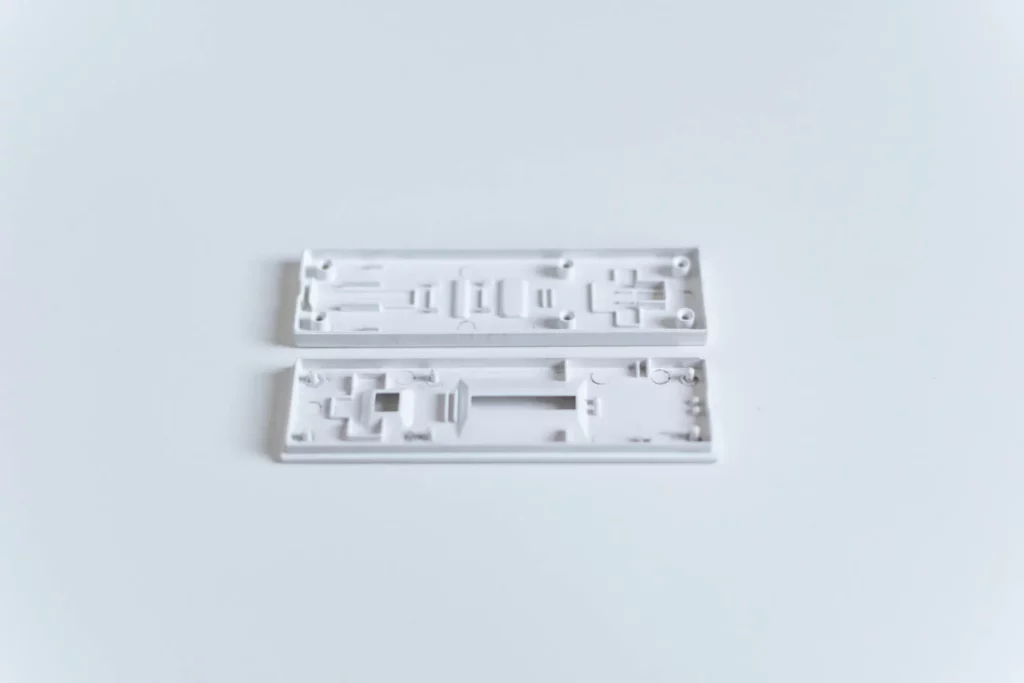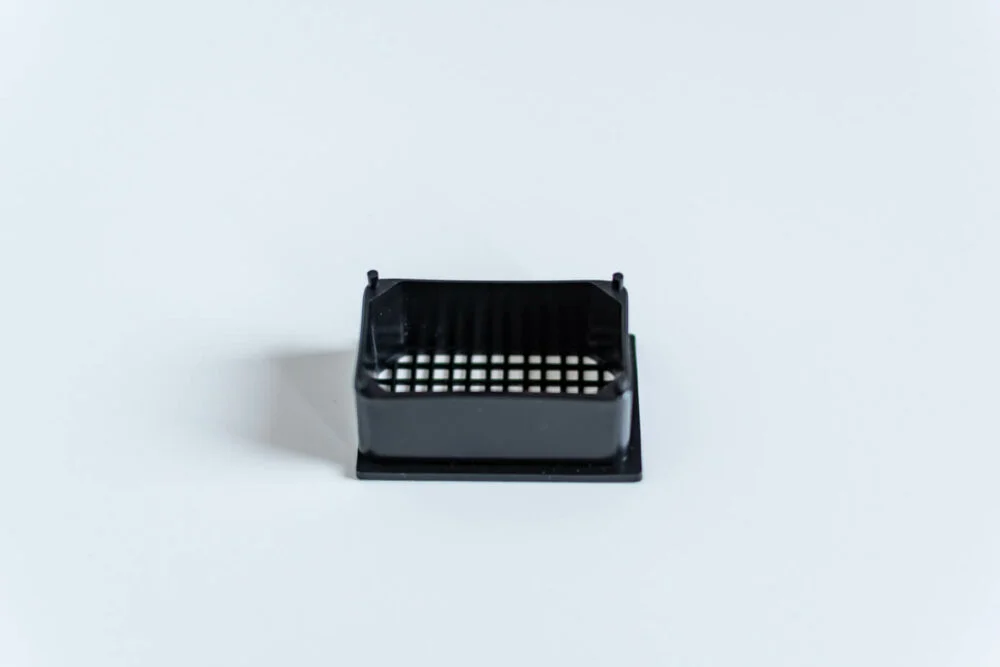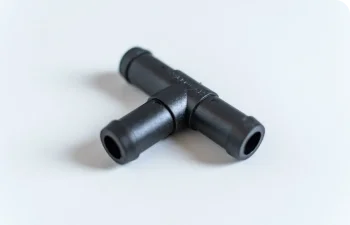Strona główna » Injection molding
Injection molding is the most popular plastic processing technology that allows the creation of precise and complex shapes on a large scale. It has a very wide range of industrial applications. The necessary tooling for production is an injection mold.
Plastic injection molding is a technique that transforms raw thermoplastics into finished products. It is used in various industries and allows the production of parts with complex shapes. Key steps in the injection molding process include heating and liquefaction of the material, injection into the mold and cooling.
Thermoplastics, which are used in this process, are a type of plastic that, at the right temperature and pressure, can be shaped by exhibiting the properties of a viscous fluid, and when cooled, harden to take the desired shape.
The plastic injection molding process, also known as injection molding, consists of four key steps.
The first stage involves preparing the plastic in granular form for injection into a mold. The plastic is heated and liquefied in the cylinder of the injection molding machine, where a specially designed screw heats it to the appropriate high temperature and causes it to melt before being injected into the mold. This gives us liquefied plastic, which is essential for injection molding technology. The temperature depends on the type of plastic.
At this stage, the mold into which the plastic will be injected is also closed.
During the actual injection stage, the injection molding machine moves the molten plastic directly into the mold cavity, filling it with properly prepared material. What follows is the molding of plastics into the shape specified by the mold.
The injection time depends on the shape and size of the part being produced.
The combination of high pressure and appropriate temperature makes the process very efficient, and the resulting products have high accuracy.
After injection molding, the plastic undergoes a cooling and curing process in the injection mold, which has a significant impact on its final shape and physical properties.
The design of the mold allows proper cooling of the molded parts and affects their quality. It should be remembered that the accuracy of the mold and its proper design is key, to proper processing.
Cooling time depends on the part being produced and affects the quality and price of the moldings.
Too much cooling time, can cause all sorts of defects.
Too much time is also not beneficial, and it increases the price and lowers production efficiency.
After opening the mold, you get the finished piece. When we use multi-cavity molds then we can produce more than one part in one production cycle.
Mould slots (their number) define the number of parts produced in one cycle
Injection molding is used in virtually every industry. Examples include:
Plastic injection molding is a versatile technology that is used in many industries. In the home appliance industry, the technique is used to manufacture a variety of items, such as packaging and various parts for home appliances.
In electronics manufacturing, plastic injection molding technology plays a key role by creating details such as smartphone cases, tablets and computer mice. This proves the precision and flexibility of this technology, which is also called artificial plastic injection molding.
The plastic injection molding method is also popular in packaging production, as it allows the creation of products with complex shapes and is useful in the production of ultralight components. With plastic injection molding technology, it is possible to create complex products.



Plastic processing by injection molding requires the use of a mold. Their construction is complex and consists of many components and systems. This is necessary because injection molding requires high processing pressures and temperatures.
Material selection plays an important role in injection mold manufacturing. High-quality steels, such as alloy steels and stainless steels, with high strength, are used. It is important to match the material to the type of plastic, the purpose of the products and the expected number of production cycles.
An injection mold consists of many systems, including. The mold cavities are that system that forms the moldings.
There are many myths about plastics and environmentalism. Indeed, the reckless use of plastics can have a negative impact, on the environment. On the other hand, a wise approach makes the impact minimal, or zero. To minimize the negative impact on the environment, the following rules should be observed.
Use secondary plastic where possible. Regranulate is cheaper than virgin plastics by approx. 10-20% and in line with the principles of a circular economy. Be careful about the quality and origin of the regranulate to avoid unwanted admixtures. Restrictions on the use of recycled plastics include. Lack of certification for food handling, lower durability and aesthetic limitations. It is worth considering the use of regranulate where it is not a problem for the final product.
Long-lasting products bring many benefits because their durability means long-lasting use, eliminating the need to frequently manufacture new components. In the case of plastic products, we extend their life by using UV additives that protect the components from the sun’s harmful rays and enable them to work outdoors for longer periods of time. This saves raw materials and reduces the negative impact of production on the environment.
Biodegradable plastics are materials that can decompose through the action of microorganisms, light, water or air. There are many types of such plastics. They are used in many industries, including. packaging, medical, agriculture and in toy manufacturing. Their advantages include. less harmful to the environment and the possibility of processing with various technologies. The disadvantage is a much higher price compared to traditional petroleum-based plastics.
Compared to other technologies, such as 3D printing or vacuum molding, plastic injection molding offers greater precision, repeatability and cost-effectiveness for high-volume production. Plastic injection molding technology is more cost-effective than 3D printing and other technologies in cases where large production runs, precise details, high surface quality and complex shapes are required.
However, for one-off production and short runs, other technologies may prove more cost-effective.
Injection molding is the most popular plastic processing technology for creating precise and complex shapes.
The injection molding process includes heating and liquefaction of the material, injection into the mold and cooling. It is a versatile technology, used in many industries, such as machinery manufacturing, automotive, medicine, consumer goods, energy, construction, agriculture, household appliances. Plastic injection molding is more cost-effective than 3D printing and other technologies in cases where large production runs, precise details, high surface quality and complex shapes are required. However, for one-off production and short runs, other technologies may be more cost-effective. Using recycled plastic, making long-lasting products and using biodegradable plastics can minimize the negative environmental impact of production.
Plastic injection molding is crucial in today’s industry, offering precision, repeatability and cost efficiency. Thanks to continuous development and innovation, plastic injection molding is a technology that will continue to play a key role in the production of various products over the years.
Injection molding is a plastic molding process in which plastic granules are melted and injected under pressure into a mold, creating a product with a specific shape and parameters.
An injection molding machine is an industrial device that enables the processing of thermoplastic materials. This is done by injecting them under pressure into a mold, where the material hardens and then takes the expected shape. These machines can be found in all sorts of factories eye industrial plants.
The injection molding machine can produce plastic parts of different colors, shapes and sizes. Even very complex components can be produced.
In injection molding, we can use any of the thousands of commercially available plastics. Virtually all of the most popular plastics, from different groups, can be injection molded.
The construction of an injection mold is very complicated, hence the high production costs. It consists of many components. In the construction of the injection molding machine, we distinguish the following systems:
forming nest
filler system
cooling system
molded part and ingot ejection system
housing
Write us what product you need,
and we will contact you within 1 hour!
office@injection-molds.eu
Plastipol Poland Sp. z o.o.
Zawadzkiego 68/7, 71-246 Szczecin
VAT: PL8522664660
KRS: 0000849574
© 2024 Injection Molds
Realization: AdWise